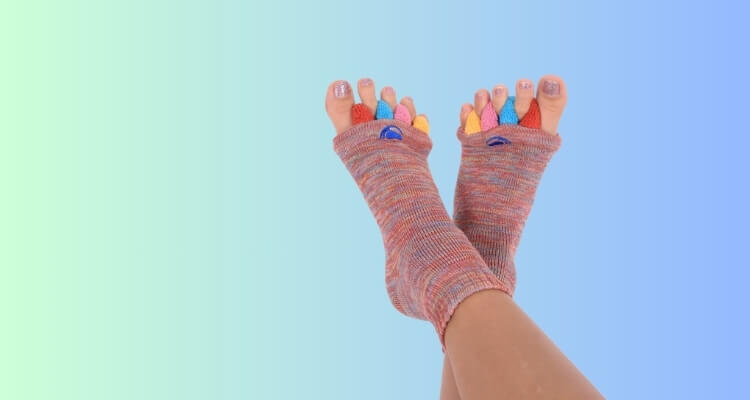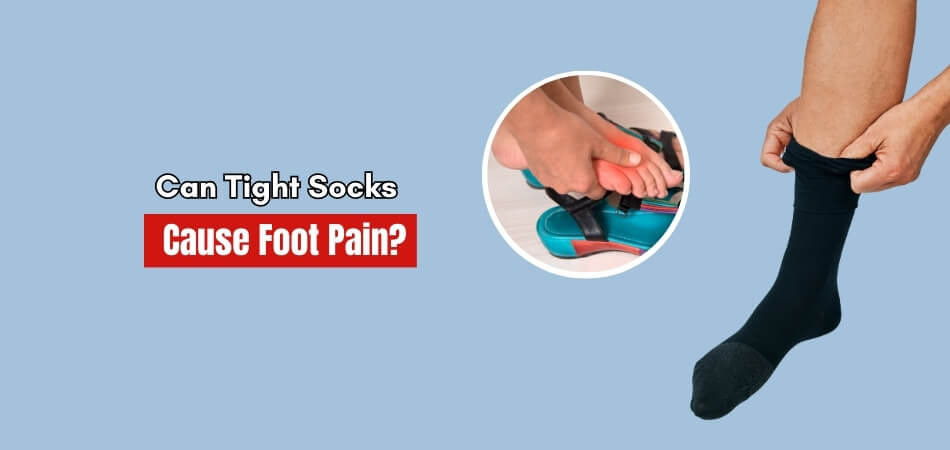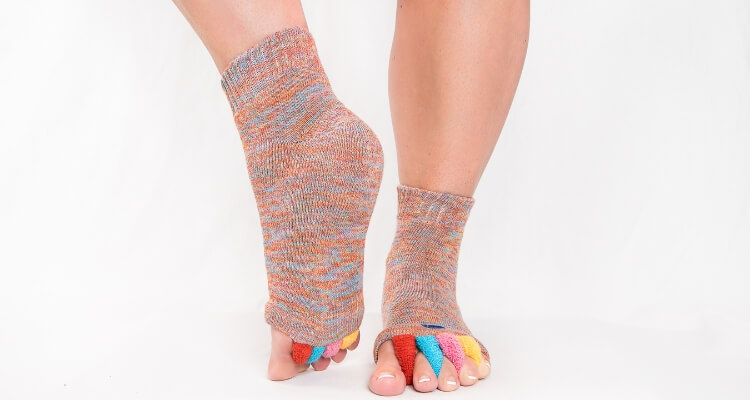This discussion is about a topic that many of us can relate to: socks. Our everyday comfort depends upon these humble garments, which are often overlooked in the world of fashion. But can tight socks cause foot pain?
Yes, tight socks can indeed cause foot pain. Socks that are too tight can restrict blood flow to the feet, resulting in discomfort, numbness, or even tingling. A tight pair of socks may also cause skin irritation, blisters, and bunions and corns to worsen. Maintaining foot health and comfort requires socks that fit properly.
We’ll explore the potential consequences of wearing tight socks in this article and discuss how to choose the right socks for optimal foot health. Get comfortable, kick off your shoes, and let’s uncover the truth about tight socks.
What is Socks?
Socks such as My Happy Feet Socks, are garments worn on the feet for warmth, comfort, and hygiene. They come in various materials like cotton, wool, and synthetic blends.

They serve several purposes, including keeping feet warm, absorbing sweat, and preventing blisters. Socks come in various styles, lengths, and materials to suit different activities and preferences.
A cotton pair of socks is breathable and comfortable for everyday wear, while a wool pair is extra warm in cold weather. Often worn by athletes or people with circulation problems, compression socks improve foot pain and blood circulation and reduce swelling. Toe socks or anti-slip socks are specialty socks that cater to specific needs.
The patterns, colors, and designs of socks can also reflect a person’s style or reflect current trends. Some people enjoy collecting novelty socks with unique prints or pop culture references. To maintain their shape and elasticity, socks should be washed regularly in cold water to prevent shrinkage.
Can Tight Socks Cause Foot Pain?
Yes, tight socks can indeed cause foot pain. When socks are too snug, they can restrict blood flow, leading to discomfort and even numbness in the feet. Additionally, tight socks can cause friction and pressure points, resulting in blisters, calluses, or even nerve damage.

Pressure Points and Friction
Tight socks create pressure points where the fabric digs into the skin, especially at the toe seams or around the elastic bands. This constant friction can irritate the skin, causing blisters or abrasions that lead to pain and discomfort.
Restricted Blood Flow
When socks are overly tight, they can compress the blood vessels in the feet, impeding proper circulation. Reduced blood flow can result in numbness, tingling sensations, and discomfort, especially during prolonged periods of wear.
Nerve Compression
Excessive pressure from tight socks can compress nerves in the feet, leading to conditions like neuropathy or Morton’s neuroma. This compression can cause sharp, shooting pains or a burning sensation, particularly in the toes or ball of the foot.
Muscle Tension
Tight socks can also exacerbate muscle tension in the feet and calves. When muscles are constricted by tight fabric, they may become strained or cramped, causing additional discomfort and contributing to overall foot pain.
What Is the Importance of Properly Fitted Socks?
Properly fitted socks play a crucial role in foot health and overall comfort. Many people underestimate the importance of wearing socks that fit well.
Support and Stability
Well-fitted socks provide essential support to your feet, helping to maintain stability and reduce the risk of injuries. They prevent your feet from sliding around inside your shoes, promoting a more secure fit.
Prevention of Blisters
One of the key benefits of wearing properly fitted socks is their ability to prevent blisters. When socks fit snugly but comfortably, they reduce friction between the foot and the shoe, minimizing the risk of painful blisters forming.
Enhanced Comfort
Socks that fit well feel more comfortable to wear throughout the day. They eliminate the discomfort caused by socks that are too tight or too loose, allowing you to focus on your activities without distraction.
Improved Circulation
Properly fitted socks help to promote healthy circulation in your feet by avoiding constriction. Tight socks can restrict blood flow, leading to discomfort and potential health issues over time.
The Impact of Tight Socks
Tight socks can have significant repercussions on foot health and overall comfort. Understanding the impact of wearing overly snug socks is crucial for maintaining foot well-being and preventing discomfort.
Blood Circulation
Restricted blood flow due to tight socks can lead to numbness, tingling, and cold feet. Poor circulation can contribute to conditions like peripheral neuropathy or exacerbate existing vascular issues.
Skin Irritation
Constant friction from tight socks can result in blisters, calluses, and abrasions. Irritated skin may become red, swollen, or develop painful hot spots, especially at pressure points like the heel or toes.
Nerve Compression
Excessive pressure on nerves caused by tight socks can lead to nerve entrapment syndromes such as Morton’s neuroma. This can cause sharp, shooting pains, burning sensations, or feelings of pins and needles.
Muscle Tension
Tight socks can exacerbate muscle tension in the feet and calves. Constricted muscles may become strained or cramped, leading to discomfort, fatigue, and decreased flexibility.
Foot Deformities
Prolonged use of tight socks can contribute to the development of foot deformities such as hammertoes or bunions. These conditions involve abnormal bending or misalignment of the toes, causing pain and difficulty wearing shoes.
Tips for Choosing and Wearing Properly Fitting Socks
Choosing and wearing properly fitting socks is essential for maintaining foot comfort and health. Here are some tips to help you find the perfect pair:

- Size Matters: Ensure you select socks that correspond to your shoe size to avoid unnecessary tightness or bunching. Socks that are too small can constrict circulation, while oversized socks may cause friction and blisters.
- Material Selection: Opt for breathable, moisture-wicking fabrics like cotton or merino wool to keep your feet dry and comfortable. Avoid synthetic materials that trap sweat and contribute to odor and discomfort.
- Seamless Design: Look for socks with smooth, seamless toe closures to prevent irritation and rubbing against sensitive areas of the foot. Seamless socks minimize the risk of blisters and hot spots, enhancing overall comfort.
- Proper Length: Choose socks that provide adequate coverage without being too restrictive or slipping down. Ankle socks are ideal for low-cut shoes, while crew or knee-high socks offer additional warmth and protection.
- Activity-Specific: Consider the activities you’ll be engaging in when selecting socks. For athletic pursuits, opt for cushioned socks with arch support to reduce fatigue and prevent injuries. Specialty socks, such as compression socks or anti-slip socks, cater to specific needs and preferences.
FAQs for Can Tight Socks Cause Foot Pain?
Are you curious about the impact of tight socks on foot pain? Below are 9 FAQs with their answers to shed light on the subject.
Can Tight Socks Cause Blisters?
Yes, tight socks can create friction and pressure points, increasing the likelihood of blisters forming on the feet.
Do Tight Socks Affect Circulation?
Overly snug socks can compress blood vessels, impairing circulation and causing discomfort.
Can Tight Socks Lead to Nerve Damage?
Excessive pressure from tight socks can compress nerves, potentially resulting in conditions like neuropathy or Morton’s neuroma.
Do Tight Socks Cause Muscle Tension?
Yes, tight socks can exacerbate muscle tension in the feet and calves, leading to discomfort and fatigue.
Can Tight Socks Contribute to Foot Deformities?
Prolonged use of tight socks may contribute to the development of foot deformities such as hammertoes or bunions.
Do Properly Fitted Socks Prevent Foot Pain?
Indeed, properly fitted socks provide essential support and help prevent issues like blisters, discomfort, and foot deformities.
How Do I Choose Socks that Fit Well?
Select socks that correspond to your shoe size and opt for materials that offer breathability and moisture-wicking properties.
Are Seamless Socks Better for Foot Health?
Yes, seamless socks minimize irritation and reduce the risk of blisters, enhancing overall foot comfort.
Can Wearing Tight Socks Affect My Athletic Performance?
Tight socks can restrict blood flow and cause discomfort, potentially impacting your athletic performance negatively. Opt for properly fitted socks to ensure optimal comfort and support during physical activities.
Final Thought
Making sure your socks fit properly isn’t just about comfort. it’s also important for your foot health. Tight socks can cause a variety of issues, including restricted blood flow, nerve compression, painful blisters, and foot deformities.
Make sure the socks you wear fit you well the next time you slip them on. Remember, “Can Tight Socks Cause Foot Pain?” Properly fitted socks provide support, prevent blisters, enhance comfort, and promote healthy circulation.
It is possible to keep your feet happy and pain-free by following simple tips like choosing the right size, material, and style. Socks are the foundation of happy feet, so don’t underestimate their power.






